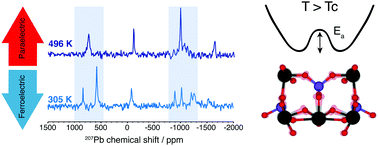Chemical exchange at the ferroelectric phase transition of lead germanate revealed by solid state 207Pb nuclear magnetic resonance†
Abstract
The nature of the dynamics and structural changes that take place at the ferroelectric phase transition in lead oxides is a rich field of study. Solid-state nuclear magnetic resonance (NMR) of 207Pb is well suited to study the local structure and disorder in lead oxide ferroelectric transitions at the atomic level. However, very large 207Pb shielding anisotropy results in poor resolution in 1D static and magic angle spinning (MAS) NMR spectra. We address this problem by using short high-power adiabatic pulses (SHAPs) with magic-angle-turning sequences to correlate the isotropic and anisotropic parts of the 207Pb chemical shift tensor in a 2D NMR experiment, yielding resolved 207Pb NMR spectra of the nine distinct lead sites in uniaxial ferroelectric lead germanate (Pb5Ge3O11). Using this technique we detect the magnetic environments of displaced Pb2+ ions and unambiguously identify the nature of the phase transition as mixed displacive and order–disorder. We also observe that the atomic-level process responsible for the phase transition in ferroelectric lead germanate is chemical exchange on the kilohertz timescale. We derive an activation energy of 103.4 ± 1.7 kJ mol−1 and compare it to dielectric spectroscopy studies on similar materials. These results show that this method can be used to characterize ferroelectric phase transitions of complex materials with high resolution using nuclei that are typically inaccessible due to their large shielding anisotropy.

- This article is part of the themed collection: 2018 PCCP HOT Articles


 Please wait while we load your content...
Please wait while we load your content...